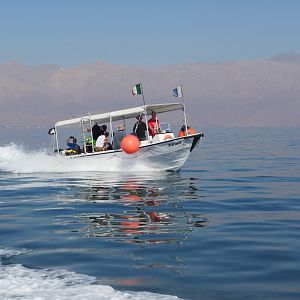You don’t "keep it up" -- putting enough weight on the string to hoist the SMB vertically needs a fair amount of weight which you're not going to add to the reel unless you're literally hanging off of it. "Hanging" on the reel/spool is a really bad thing as you will be overweighted: you'll drop like a stone if the bag/string breaks, you'll probably be vertical (bad for decompression), it's lazy, you're not in control.
You are neutrally buoyant at your stop. You don't need to hang on to the reel/spool as you're drifting in the current just as fast as the SMB. The surface wind will slowly blow the SMB along so you may gently fin behind it (it's slow because of the drag of the string and reel).
Most importantly the reel/spool bobs up and down with the surface waves which you'll be unaware of at 6m/20' -- unless a storm has blown up! With larger waves the reel/spool will bob up and down a fair way, sometimes 2m/6' in bad conditions, or when a passing ship's wake runs through.
I tend to have the reel/spool set a couple of feet / 60cm below me and back off from it. Then there's a visual reference for your depth without watching your computer like a hawk. Actually you can sense through the pressure of your drysuit if you're ascending/descending.
If you've a long final stop it's almost zen-like where you can do what blokes like doing most... nothing. It's really calming like meditating as there's literally nothing you can do whilst you wait for your surface GF to drop to GF-hi. Personally I like that "me" time.
SMB sizing...
This has to be said. An SMB is useless if it's small or not properly inflated. The boat skipper/captain needs to be able to see and identify it on the surface within the field of drifting SMBs. A pathetic weedy little training SMB -- one of those 1m/3' things you fill with one breath -- has no place on a real dive. Those are training blobs purely for quarries. You need a thick and long one. Girth matters enormously as does length. Skinny ones are hard to see.
When you're inflating them on the bottom, it's much easier to completely fill the SMB when inflating deeper as the gas is at a higher intermediate pressure for the same amount of injection time. Thinking of the typical Halcyon et al SMBs with the inflator spigot which you connect your drysuit inflator hose to.
Big, in this case, is better.
It is massively easier to use a self-inflating SMB such as a 'crack bottle' or CO2 cylinder(s) to inflate it. My primary of choice is 2m/6'6" long and pretty thick, it's inflated with two 16g CO2 cartridges so is incredibly quick and simple to inflate -- especially on a rebreather where you don't have endless gas supplies.
The colour is orange or red. Yellow, in technical diving, is generally taken as an emergency signalling SMB, as you would have agreed with the boat in advance what you want them to do should you send up a second small yellow SMB up the string. Yes, advanced diving, but it might mean that you want them to send down your emergency deco cylinder from the boat.
On the surface...
When you've completed your final stop you will slowly ascend to the surface. 1m/3' per minute is often used as a guide.
Just before you leave your final stop you'll do a quick check of everything. Make sure your hoses are all neatly stowed away (if using multiple deco cylinders); make sure they're properly clipped off; tuck your umbilical torch cable in. Basically you don't want to look like a sack of *** when you surface, but most importantly you don't want to have hoses/cables/whatever catching on the boat as you climb out otherwise it's an expensive day.
Arriving on the surface you inflate your BCD/wing and close your drysuit dump. Then you hold on to the SMB and raise it vertically to let the boat see you're up. Then wait for them to come to you and pick you up. It's amazing on the surface just how noisy and horrible it is in comparison to the past hours(?) spent on the dive and at deco. Mayhem describes it nicely when the wind's picked up since you jumped in.
When the boat passes beside you, you will pass the SMB up to someone leaning over the side (another reason for a long SMB). Then you can get around to the stern to climb into the dive lift -- or ladder if you're in the US ; how quaint!





